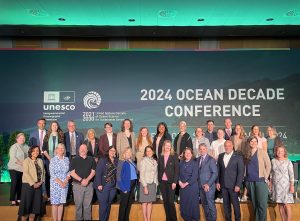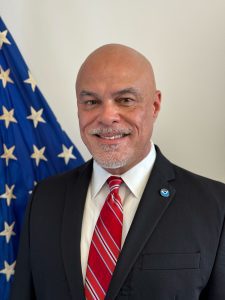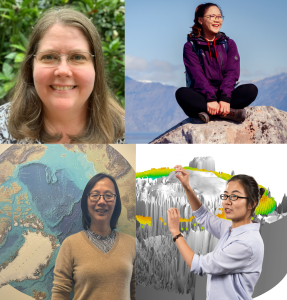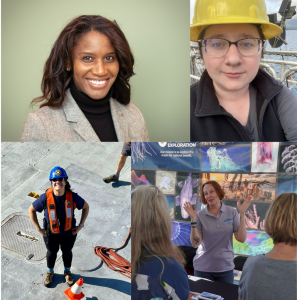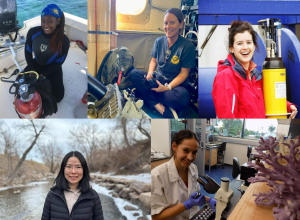To celebrate Women’s History Month, we asked women throughout NOAA Research who make lasting impacts in scientific research, leadership, and support from the field to the office to share how their work contributes to NOAA’s mission of Climate Resilience and preparing for a Climate-Ready Nation. This article highlights an interview with Liping Zhang, a research scientist who works in the Seasonal-to-Decadal Variability and Predictability Division at NOAA’s Geophysical Fluid Dynamic Laboratory (GFDL).
Our conversation follows:
What projects or research are you working on now, and how does your work contribute to climate resilience?
My research focuses on the decadal to centennial climate variability and predictability, including the Atlantic multidecadal oscillation, the Pacific decadal oscillation, and the Southern Ocean centennial variabilities. My work aims to explore the mechanisms that cause variability, and the impact of human-caused (anthropogenic) forcings using both observations and climate models.
My most recent work focuses on the multiyear to decadal prediction of sea level over the North Atlantic Ocean and U.S. east coast. This study is to advance scientific understanding of the connections between the Atlantic Meridional Overturning Circulation (AMOC) and mean sea level/extreme sea level (ESL) events along the U.S. east coast. The ocean has been undergoing profound changes, and the sea level along the coasts, which is directly relevant to human society, is no exception. In the North Atlantic Ocean, the accelerated sea level rise is threatening coastal communities along the entire U.S. east coast, and the rapid warming of coastal waters is altering marine ecosystems. For mitigation and planning purposes (central to climate resilience), it is important that we develop good prediction skills for future changes of sea level. This research will help us better understand what causes changes in sea level along the U.S. east coast and how sea level is related to the AMOC. The improved understanding will contribute to better predictions and enable better socioeconomic management and decision making.
What does climate resilience or climate-ready nation mean to you? What would you want people to know about NOAA’s work on climate resilience?
A climate-ready nation is one whose prosperity, health, security, and continued growth benefit from and depend upon a shared understanding of collective action to reduce the impact of climate change. NOAA works with federal partners, tribes, communities, and businesses across the U.S. to provide products and services that bolster resilience in the face of climate change. For example, NOAA helps coastal communities adapt to sea level rise; provides early drought warnings to farmers, rural residents, and tribal and indigenous communities; works with urban communities to map heat inequities; and collects and stores the authoritative record of greenhouse gas measurements and historical weather, ocean, and climate data.
In my division at GFDL, we have two initiatives this year focused on western U.S. drought and sea level predictability along U.S. coasts. We aim to understand the physical processes leading to changes in the drought, including both impacts from anthropogenic forcings and natural variabilities. We are exploring the seasonal to decadal predictability of sea level to evaluate whether the improvement of model resolutions could enhance the accuracy of sea level predictions.
What do you enjoy most about your work?
I enjoy learning new things and doing creative work. I like that my work allows me to explore the unknown and discover new and exciting findings. I like the sense of accomplishment of solving scientific questions in the climate science community, and I enjoy using logical thinking to untangle problems step by step. I also enjoy the freedom to pursue research topics that I’m deeply interested in as well as the opportunities to work with many curious and enthusiastic colleagues, postdocs, visitors, and interns. It is very rewarding to see the scientific and professional development of my interns and visitors, and have the opportunity to collaborate and share my experiences with them.
What challenges have you faced as a woman in your career and how have you overcome them?
Finding a balance between career and family is a big challenge to women. When kids are very little and our career is in a rising stage, it is very hard to perform both well at the same time. When Covid-19 started, I was working remotely from home and also taking care of my kids, one is two years old and the other is six. At the beginning, my life was quite chaotic and exhausting, but gradually I handled it better and better. In my experience, it is very important to help little kids establish their own routine through making a timetable. It is also important to cultivate children’s habit of reading and be a role model for them. When my kids have a pleasant and meaningful daily life at home, I can find a lot of time to concentrate on my work. When they are reading, painting, or playing, I can conduct numerical experiments on my computer. When they take a nap, I can join virtual meetings. After they go to sleep at night, I can spend three to four hours coding, thinking, or writing manuscripts. During the weekend, I drive my kids to different classes (e.g., piano class, painting class). When I wait for them in my car, I like to read literature, think about my research, and then make a clear work plan for the following week. I take advantage of all those fragments of time to ensure my work and career progress is not delayed.
To hear more about how the Covid-19 pandemic affected women at NOAA, check out profiles from the 2021 Women’s History Month campaign.
Do you have a favorite moment or accomplishment in your career?
I have two favorite moments of my career so far where my research was covered by the media. In 2019, I was the lead author in a paper published in Nature Climate Change titled “Natural variability of Southern Ocean convection as a driver of observed climate trends”. We proposed a new mechanism to explain the observed Southern Ocean Sea surface temperature and Antarctic Sea ice trends from 1979 to 2015. This paper gained media attention and I was quoted in a story by Carbon Brief. Also, at the end of 2022, I published another paper in Nature Profile Communications Earth & Environment. This study suggested that the observed persistent Antarctic Sea ice declines after 2016 were partially attributed to the subsurface warming over the Southern Ocean, which was predictable on multiyear timescales. This paper again attracted media attention, and I was quoted in the Washington Post. These media interviews were very encouraging and exciting because they not only recognized my work, but also indicate that our research is beneficial to the nation, people, and society.
Special thanks to Liping Zhang for participating in this interview for Women’s History Month at NOAA.
